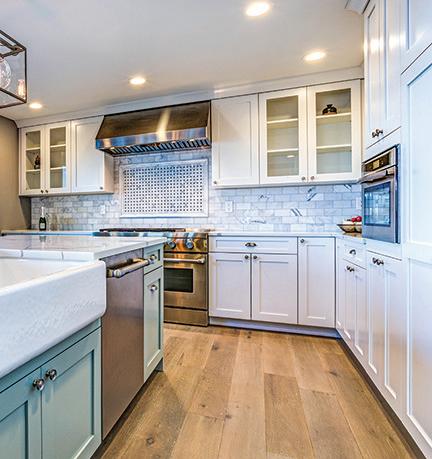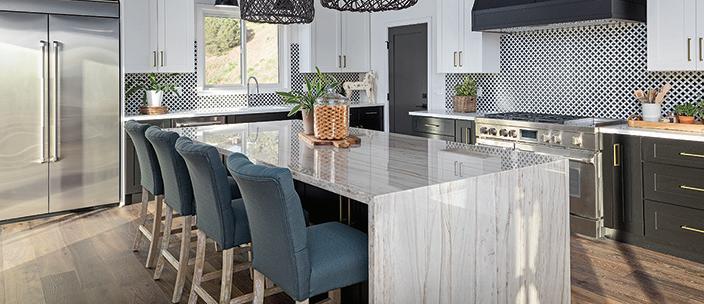









Homeowners renovate their homes for a variety of reasons. Renovations can increase the value of a property and make homes safer and more comfortable for their occupants. Improvements also can be made to stay current with the times or to give a home a new vibe.
Statista projects $510 billion will be spent on home improvements in 2024. The home improvement market is generating significant revenue. In fact, nearly a quarter of Americans opting to renovate their homes will spend an average of $10,000 on their projects. According to a Home Stars Renovation report, 8 percent of Canadian homeowners who have renovated have spent more than $20,000 on a home improvement project.
Kitchens and bathrooms often get the most attention when it comes to home improvement. However, every room and space in a home may need a renovation at some point, and the following are five signs it’s time to renovate.
1. Age
The National Association of Home Builders states that 50 percent of U.S. homes are over the age
of 40. That means that age alone could dictate a need to renovate, particularly if some materials are original to the home. For example, asphalt roofs typically last 25 to 30 years, while window frames can last 20 to 50 years depending on how well they have been maintained.
2. Inconvenient layout
Some homeowners scratch their heads when faced with awkward floor plan layouts. While one may live with the inconvenience for some time, typically a floor plan that isn’t working for the homeowner is a major driver of renovations.
3. Outdated looks
A home can look dated even if it is a relatively recent build. That’s because trends change quickly. For example, dark, cherry cabinets that were popular just a little while ago have now been replaced by lighter color palettes. Homeowners whose homes do not match the looks emulated in design magazines may consider a change, particularly if they’re planning to sell soon.
4. Deterioration
Signs of water, storm or structural damage should be addressed as
soon as possible. Any deterioration should be a strong indicator that it’s time to renovate.
5. Efficiency Escalating utility bills could be indicative of an inefficient home.

Homes are often characterized as sanctuaries for their residents. A calm place to come home to after a busy day at work or school is often just what people need to unwind.
Certain design components can help individuals turn their homes into relaxing respites from the daily grind. With that goal in mind, individuals can consider these ideas to create a peaceful feel inside their homes.
• Paint with neutral colors. Wall colors can define the mood in a given room, and neutral colors have long been linked to a calming effect. Subtle shades like beige, taupe and light gray are known to create a relaxed vibe in a room, so these colors can be a go-to choice. Some people consider neutral colors a tad boring, so individuals concerned by that impression can limit neutral colors to rooms designated as sanctuaries, like a reading room, a spa bathroom or a bedroom.
• Employ natural light. Natural light also can help to establish a serene setting at home. Large win-
dows that let daylight in can improve anyone’s mood. A 2022 study from researchers at the University of Chile in Santiago found that the more natural light that entered a home, the happier people said they felt. Study authors even noted that the largest uptick in well-being was found among participants who lived in homes in which windows covered at least 40 percent of the dwelling’s wall space. Opening blinds or curtains and, if possible, installing larger windows in a home can help to establish the relaxing, happy vibe individuals are aiming for.
• Utilize plants to set a peaceful tone. The United Kingdom-based Royal Horticultural Society notes that research has found that indoor plants can benefit psychological well-being. The RHS notes that improved mood and reduced stress levels are two benefits that indoor plants can provide. A good mood and less stress can help individuals establish the peaceful feel they’re aiming for at home.
• Keep devices out of bedrooms. Watching television while lying in bed, scanning a smartphone before turning off a nightstand light and retiring for the night, or reading an e-reader instead of a print book at night can transform a bedroom from a serene setting into one that’s overrun with stimuli. According to the Sleep Foundation, technology stimulates the mind, which can make it harder to fall asleep. In addition, blue light emitted by devices disrupts the natural production of melatonin, a hormone that makes it easier to fall asleep. That can negate any efforts individuals have undertaken to make their bedrooms as peaceful as possible. Designate bedrooms in the house as technology-free zones to ensure the peaceful vibe continues uninterrupted until everyone goes to bed.
A peaceful home makes for the perfect respite at the end of a busy day. Various design choices can help individuals establish a serene vibe throughout their homes.
Homeowners can conduct energy audits and then improve the areas where energy loss may be occurring, such as windows, doors, siding, and insulation.
Homeowners can renovate their homes when they see fit, but various signs may warn that it’s time consider updating or remodeling a home.

Houses typically feature various areas that are traditionally designed for storage, such as garages, basements and attics. However, with some renovation, these spaces can be transformed into livable areas.
Homeowners who would like to convert attics into livable spaces need to take certain things into consideration before starting an improvement project. While the attic may seem like it has plenty of room and is structurally sound enough to walk in, that’s not necessarily so. To be converted into usable living space, an attic must be brought up to the standards of modern building codes, according to the design experts at Board & Vellum. Retrofitting beams and insulation can eat up available space in an attic. Thus, it is best to consult an expert to see if an attic can be converted.
Furthermore, an attic that was not initially designed as a room when the house was built can add extra “load” upstairs if it is converted. That could present certain structural problems. That means a structural engineer also must be consulted to see if adding beams, flooring and drywall will neces -
sitate other changes elsewhere in the home to accommodate the extra load.
In order to have a functional attic room, building codes will dictate that it needs to be accessible by a full-size staircase. Also, it will need to have another exit in case of an emergency so that will likely be an accessible window, according to the home information site The Fill. Homeowners’ budgets and renovation plans will need to factor into these considerations. Homeowners also are advised to check local permits to determine what else may be required to go forward. It is best to follow the rules. Lack of a permit for work can affect the ability to sell a home down the line.

Individuals also should plan for heating and cooling upgrades as the home will need to have ductwork installed in the attic, or at the least, a stand-alone heating and cooling unit. As heat rises, it can get quite warm in an attic, so ventilation and comfort should be considered. The attic will need to be wired for electricity for lighting and other needs. Air sealing and additional insulation can the attic space more comfortable as well.
Consult with a qualified electrician and an HVAC technician and have an energy audit done to discuss needs.

Attic renovations can give homeowners more space in their homes, which can be used as offices, bedrooms or cozy corners.
This is no small undertaking and all of the right steps need to be followed to ensure a legal, safe and successful renovation.
A kitchen is often the most utilized room in a house. Meals may be prepared, cooked and often eaten in kitchens, and the room is often utilized as a homework spot or a makeshift place to pay bills and stay on top of household needs. By enhancing the organization and functionality of the kitchen, homeowners can enjoy these popular spaces even more.
Homeowners have increased their spending on home improvements in recent years. According to the Joint Center for Housing Centers for Harvard University, project spending rose to $472 billion in 2022 from $328 billion in 2019. It’s estimated consumers will have spent $485 billion by the end of 2023. Kitchen renovations were the most popular upgrade and accounted for the highest budgets in 2021, according to Houzz. When the time comes to renovate a kitchen, homeowners can take steps to make these spaces more organized and therefore functional. Here are eight tips to creating a more functional kitchen.
1. Increase storage, and then invest in more. Make the most of corner cabinets and other potential dead spots in a kitchen. Various products can be used to organize awkwardly angled or shaped areas. Kitchen designers also can work with you to reconfigure cabinets and kitchen layouts.
2. Organize utensils and dishes around the sink/dishwasher. Rather than traversing the kitchen to put clean dishes away, make loading and unloading the dishwasher that much easier by locating commonly used items next to and above it. Similarly, place frequently used saucepans, baking dishes and other items near the oven or food preparation area.
3. Utilize drawer and cabinet organizers. Make a place for everything in the kitchen. Take out all items and see what you need and use all the time. Then coordinate storage around those items so everything fits perfectly. Pull-out shelves and Lazy Susans also can facilitate access.
4. Add shelves to cabinets. If
you can afford to have a custombuilt kitchen, by all means design cabinets according to preference. If you’re using standard cabinets, you may have to reconfigure shelves and spacing to fit the items you have. This also will help you maximize cabinet space.
5. Organize the garbage. Have a pull-out drawer or cabinet to store trash bins. Separate compost, trash and recycling needs.
6. Create continuity in the room.
Many open concept homes will have kitchens open up to another room in the home. Mirror the design scheme from elsewhere in the house, and make sure that the flow between spaces is not obstructed.
7. Create a beverage station. A beverage station can minimize the time needed to make a cup of tea or coffee or for the kids to grab juice or chocolate milk.
8. Have a workspace in the kitch -

The kitchen is a busy room in many homes. That popularity likely has something to do with why so many homeowners spend sizable sums renovating their kitchens. According to highlights from the 2022 U.S. Houzz Kitchen Trends Study, the median spend on major kitchen remodels grew by 14 percent from the previous year, and minor remodels increased by 25 percent. Spurred on by increased time spent at home during the pandemic, the main impetus for kitchen remodels according to the study was that homeowners wanted to make these improvements all along and finally had the time and means to do so.
There are many aspects of a kitchen that homeowners can change. Houzz found 94 percent of renovators either fully or partially replaced cabinets in their improvement plans. Cabinets are a major component of kitchen layouts. Cabinets help to establish the aes-


en. Whether paying bills, making a grocery list or leaving notes for the family, a dedicated workspace can add more function to the room. Be sure there is task lighting nearby and ample overhead lighting to ensure that all kitchen needs are illuminated properly. A more functional kitchen can make this already popular space even more so.
thetic of a kitchen and serve a useful function, providing necessary storage space to ensure the room does not appear cluttered.
Homeowners have different options when it comes to cabinet renovations, and they may need to decide if they need to replace or reface their cabinets.
Replacement
Cabinet replacement involves removing all of the existing cabinets before new cabinets are leveled and installed. According to the home improvement resource The Spruce, homeowners can expect to pay between $13,000 and $30,000 for contractor grade cabinets. Cabinet replacement is a good idea when homeowners want to add more cabinet space or create a new layout in the room.
Refacing
Cabinet refacing is less messy and less disruptive than replacement. All
cabinets remain the same size and in the same location. The cabinet boxes must be in good shape to facilitate a refacing. The process involves installation of new drawer fronts and cabinet doors, as well as veneering of the cabinet boxes.
New hardware typically is installed as well. The insides of the cabinets typically remain the same. The Spruce says cabinet refacing can be 30 to 50 percent cheaper than a replacement.
Most people call in professionals to change their cabinets. Cabinet replacement can be a do-it-yourself job, but it involves measuring and ensuring everything fits and is leveled appropriately.
Homeowners who choose to reface their cabinets themselves may opt to paint or restain. Wood veneer or a new door and drawer panel installation can be complicated and is best left to qualified contractors.
The home renovation industry is booming, and that’s reflected in the cost to upgrade a home. Home Guide says remodeling a kitchen costs $25,000 on average, and a bathroom renovation runs around $10,000. Though rates fluctuate depending on a host of variables, renovations can cost $15 to $60 per square foot depending on the project.
The average homeowner wants to save as much money as possible when renovating their home. Many think doing much of the work themselves is the easiest way to keep costs low. What some homeowners may not realize is that DIY can be costly and prove a big hassle in the long run. The following are some hidden costs of DIY and renovating in general.
Time
DIY projects are a major drain on free time. Homeowners taking the DIY route typically work on weekends or after work. Few people can take off and devote their undivided attention to a remodel like a contractor can. Time is a valuable re-
source that is not renewable. Therefore, think of a DIY project in terms of what it would equal in lost wages. Because homeowners are not professionals, a DIY project may take double the time it would take a contractor. It may be worth it to simply hire it out.
Mistakes
Many resources are available to help DIY enthusiasts work on a project, but there are still tricks and techniques learned after years on the job. DIYers may damage their homes by taking shortcuts or not understanding how to do a job properly. A plumbing mistake, for example, may lead to flooding that damages another room in the home. And such mistakes may not be covered by homeowners insurance policies.
Fines
Permits are required for many home improvement projects. Forgetting to obtain permits or not realizing one may be necessary could subject you to hefty fines and/or force the job to be redone so it’s up to code. Professionals likely know the rules regarding permits and often
include the cost of acquiring permits in an estimate.
Remediation
It’s only after opening up walls or removing floors that you may discover issues you did not anticipate, such as termite damage or mold. These unforseen factors can drive up the overall costs of a project.
Disposal
Removing old building materials or gutting a room is part of many renovations. Chances are this refuse simply cannot be left at the curb for trash pickup. As a DIYer, you may not factor the costs for a dumpster or the time and money required to haul debris to a recycling or landfill center.

Tools
DIYers may have to purchase tools as they engage in new projects. These expenses can add up and negate the savings of doing some of the work yourself.
DIY projects may initially seem like a way to save money, but weekend warriors should calculate the hidden costs associated with DIY renovations before deciding to do some work on their own.






Home renovation projects were high on homeowners’ priority lists during the early days of the COVID-19 pandemic. Throughout much of 2020, people across the globe were forced to spend much of their time at home as leaders and governments across the globe sought to prevent the spread of COVID-19. More time at home compelled millions of homeowners to invest more in their properties, thus sparking a renovation boom.
By early 2023, the renovation boom that marked the initial days of the pandemic appeared to have burst. In May 2023, the popular home improvement retailer Home Depot reported its sales had fallen by 4.5 percent in the first quarter of the year and that its income had fallen by more than 6 percent from the same period a year earlier. That marked the end of what Home Depot CEO Ted Decker characterized as “a three-year period of unprecedented growth” in the home improvement sector.
Home Depot’s decline in sales was attributed to a number of factors, including a pivot among homeowners from large projects to smaller renovations. Inflation and the looming threat of a recession have led many homeowners to emphasize smaller projects. With that in mind, the following are some small renovations that can have a big impact.
• Storage addition: Regardless of where storage is added, be it the kitchen or a home office or a laundry room, extra space to keep items out of

view can dramatically alter the look of a home. Unused kitchen walls can be transformed with some inexpensive, easily hanged shelves, while some laundry pedestals with storage drawers can help keep washrooms clear of clutter.
•Polish floors: Elbow grease might be the biggest expenditure when cleaning hardwood floors. The wood flooring experts at Bona® advise homeowners to polish their floors once every two to four months depending on how much foot traffic the floors get. A fresh polishing can make floors look brand new and ensures dirt and dust are not hanging around as uninvited houseguests.
• Paint: Painting is another inexpensive option for budget-conscious homeowners who want to update their homes. There’s no shortage of places in a home, both inside and out, where a fresh coat of paint can make a statement without breaking the bank. Fading paint on bedroom walls and kitchen cabinets can be painted over with a fresh coat of the same color or even something more vibrant. Outside, apply a fresh coat to a wooden deck or paint over brick siding to create a whole new look.
• Molding: Crown molding can add a touch of elegance to any room. Rooms can be transformed in a single weekend with the installation of new or replacement crown molding. A simple molding installation is a task many do-it-yourselfers can handle on their own, while homeowners with less DIY experience may benefit from hiring a contractor to create a layered molding look.













